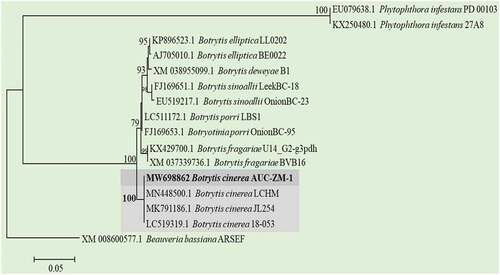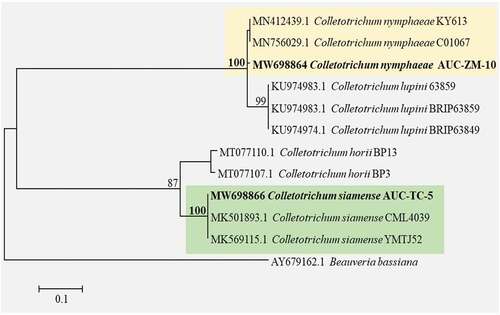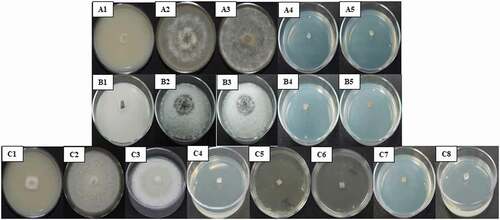Figures & data
Fig. 1 Phylogenetic relationship of Botrytis cinerea (AUC-ZM-1) isolated from Zamora, Michoacán, Mexico, based on a region of the glyceraldehyde-3-phosphate dehydrogenase (GAPDH) gene with a cut-off value of 70%.

Fig. 2 Phylogenetic relationship of Colletotrichum nymphaeae (AUC-ZM-10) isolated from Zamora, Michoacán, Mexico, and C. siamense (AUC-TC-5) isolated from Tecomán, Colima, Mexico, based on a region of the glyceraldehyde-3-phosphate dehydrogenase (GAPDH) gene with a cut-off value of 70%.

Fig. 3 Mycelial growth inhibition of Botrytis cinerea (A), Colletotrichum siamense (B), and C. nymphaeae (C) by fatty acids. Only those treatments that showed 100% inhibition are shown. A1, B1, and C1) Positive control: Thiabendazole. A2, B2, and C2) Absolute control: PDA + fungus. A3, B3, and C3) Negative control: Absolute ethanol for hexanoic and decanoic acid, water for sodium octanoate. A4 and A5) B. cinerea inhibition by decanoic acid (1000 and 2000 µM, respectively). B4 and B5) C. siamense inhibition by decanoic acid (1000 and 2000 µM, respectively). C4, C5, C6, C7 and C8) C. nymphaeae inhibition by hexanoic acid (2000 µM), sodium octanoate (1000 and 2000 µM, respectively), and decanoic acid (1000 and 2000 µM, respectively).

Table 1. Inhibitory effect of fatty acids on mycelial growth of Botrytis cinerea.
Table 2. Inhibitory effect of fatty acids on mycelial growth of Colletotrichum spp.
